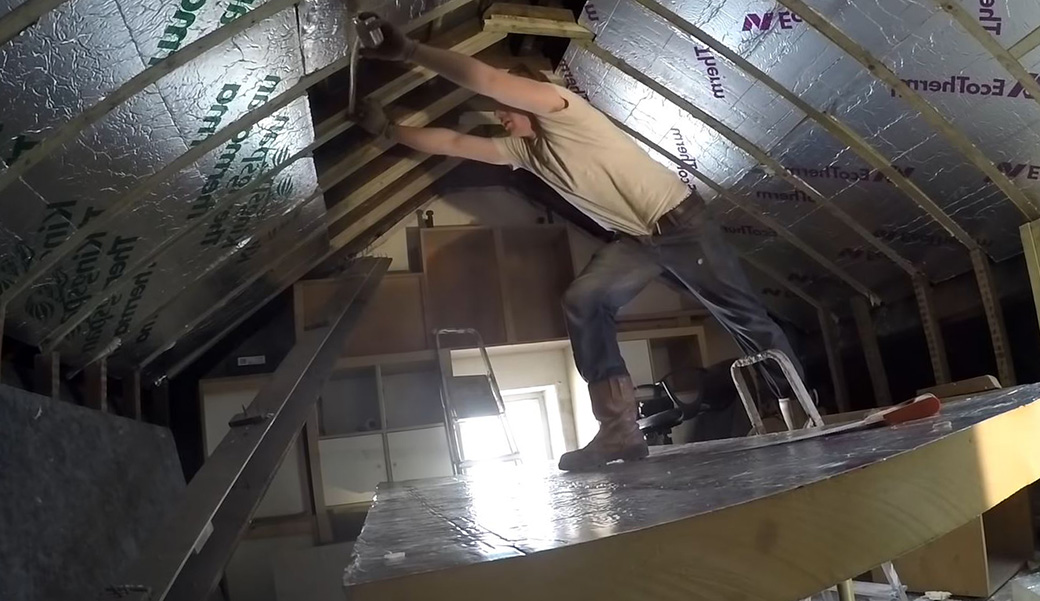A Simple Guide to Roof Insulation
If you don’t insulate your roof properly, your heating bills could go up during the winter. Hot air rises, so a poorly-insulated roof is going to let that hot air out, where as a well-insulated roof will retain it, keeping your home feeling warmer for longer. You will need your heating on for a lesser amount of time, and at a lower temperature. Both of these things will bring your energy bills down. It has been estimated that as much as a quarter of all heat is lost from a poorly-insulated roof during the winter.
Wouldn’t it be nice if your heating were 25% cheaper?

ROOF INSULATION — WHERE IT SHOULD BE
There are actually three places within your roof and attic structure that you can use as space for insulation material. The majority of homes have a roof where insulation sits underneath the floor of the loft/attic. If the attic isn’t actually used regularly, this is a smart choice. You don't need the heat to be in the attic, so having insulation below it, rather than above it, will mean more heat for your home. This is considered to be one of the cheapest methods of insulation your roof, but this does depend on the products you choose and whether or not you have it professionally installed. The latter will incur labor costs.
If you have converted your attic into a living space, attic floor insulation won’t work so well. The room will always be very cold. In these cases, you can choose to insulate the roof on the inside of the cladding or on the outside.
The easiest and quickest way to insulate your home is to choose to insulate on the INSIDE. Outside insulation often requires the removal of the cladding and other parts, making it a big job. Insulation installed on the inside does not usually need such treatment, making the job not just quicker and easier, but also cheaper. The downfall is that you are more likely to have gaps in the internal insulation, causing small areas where heat can escape. External insulation is less likely to do this, but can be more expensive than both internal insulation and attic floor insulation.
Your requirements will have a big part to play in which insulation location you decide upon. If the attic is prone to damp, internal insulation is considered the best choice, but you are going to lose some of the space by doing this — reducing the height of the area.
ROOF INSULATION MATERIALS — A CHOICE OF 3
There are three main types of insulation material that you can use in or on your roof — loose-fill insulation, insulation boards, or insulation foam.
LOOSE-FILL INSULATION
Loose-fill insulation usually comes in one of three forms — polyurethane foam spray (PUR spray), blown cellulose, and blown fiberglass. PUR spray foam is considered the best option for a completely sealed unit, expanding to fill all gaps and crevices and keeping things watertight. It is best used in the cavities of walls and inside pitched roofs and is well-known for its high insulating properties, but still has a few downsides. To start with, the foam spray is not a recyclable material. Adding to that, it can smell very strongly for a number of days after installation.
Fiberglass insulation is another blown-in option, often used in pitched roof types and wall cavities, just like PUR spray foam, and it's one of the cheapest methods of insulating your home or building. There are many other benefits, but some of the best selling points include — it is very resistant to damp and moisture, can be completely recycled once it’s time to change it up again, and it leaves your roof air and watertight.
If you wanted an option for attic floor insulation, you may find that cellulose fits the bill. This is not only recyclable, but also made from recycled materials, usually paper and newspaper. It is the most planet-friendly option of the bunch, and offers great insulation properties for a relatively cheap price.
INSULATION BOARDS
You have three materials of insulation boards to choose from — extruded polystyrene (XPS), polyisocyanurate (PIR), or polyurethane (PUR). PUR is known for being the best for insulation your building, and is great for a wide variety of spaces, including flat and pitched roofs, basements and floors, and also cavity walls. There are many visual options for this type of insulation, and it is often combined with PUR foam spray for a completely watertight seal.
PIR insulation boards are best if you want something that has a high resistance to fire, will insulate your home well, and will keep moisture and damp at bay, especially for floors, and flat and pitched roof types. This type is stronger and more durable than PUR, and that means it comes with a slightly higher price tag.
Finally, we come to XPS or extruded polystyrene insulation boards. These are quick to work with, making the labor and installation costs slightly cheaper than other options, and they’re super strong and resistant to pressure. This makes them great for flat roofs and floors.
If you need to get your roof re-insulated but aren’t sure where to start, give your local roofing contractors a call.
Visit our Roof Contractor home page to learn more about us, or hire a local professional from over 100 USA locations.

